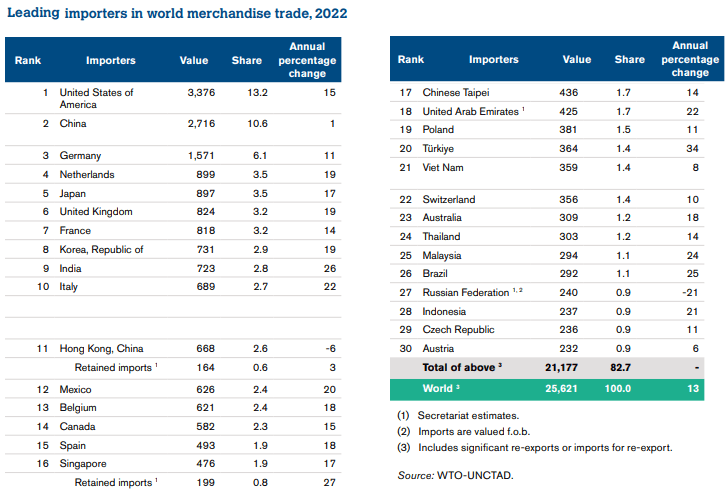The United States, China, Germany, the Netherlands and Japan were the world’s top product importers in 2022 according to data from the World Trade Organization (WTO).
This is how they recorded their respective amounts: United States (3 trillion 376 billion dollars), China (2 trillion 716 billion), Germany (1 trillion 571 billion), Netherlands (899 billion) and Japan (897 billion).
At year-on-year rates, their percentage change was as follows: United States (+15%), China (+1%), Germany (+1%), Netherlands (+19%) and Japan (+17 percent).

According to the International Monetary Fund (IMF), a broader deterioration in the geopolitical environment would further exacerbate trade tensions and supply disruptions globally, in the context of already increasing trade restrictions.
This could result in trade fragmentation, for example, through the creation of new trading blocs based on friendshoring, disruptions to established global value chains, and a reorganization of the international monetary system with implications for the composition of reserve assets, payment systems and exchange rates.
Product importers in the world
The IMF believes that the need to adapt to new trading blocs would add stress to already strained supply chains.
While a more fragmented trading system could increase or decrease global balances, depending on the exact reconfiguration of trading blocs, it would unequivocally erode the welfare gains from globalization, reduce technology transfers and diminish the potential for export-led growth in low-income countries.
The current account surplus of advanced surplus economies is projected to shrink as a percentage of GDP in 2022 across the board.
In Germany, the projected decline in the surplus by 1.3 percentage points of GDP is driven by an increase in the cost of energy imports and a collapse in exports to Russia stemming from Ukraine war-related sanctions.
In Japan, the projected reduction in the current account surplus by 1 percentage point is due to higher energy costs.
However, the U.S. current account deficit is expected to remain elevated at 3.7% of GDP, with the decline in government saving being offset by a decline in private saving and an increase in investment.
Also, the IMF expects China’s current account surplus to decline by 0.4 percentage points of GDP to 1.4% of GDP in 2022, driven by an increase in investment.

